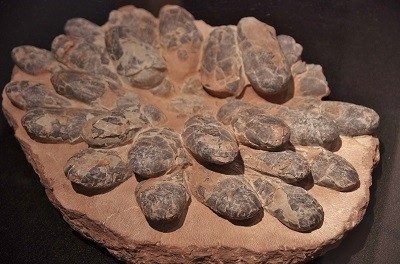FOR IMMEDIATE RELEASE
ACS News Service Weekly PressPac: June 30, 2021
Digging into the molecules of fossilized dinosaur eggshells
“Molecular Analysis of the Mineral Phase and Examination of Possible Intramineral Proteins of Dinosaur Eggshells Collected in El Rosario, Baja California, Mexico”
ACS Earth and Space Chemistry
Dinosaurs roamed the Earth more than 65 million years ago, and paleontologists and amateur fossil hunters are still unearthing traces of them today. The minerals in fossilized eggs and shell fragments provide snapshots into these creatures’ early lives, as well as their fossilization processes. Now, researchers reporting in ACS Earth and Space Chemistry have analyzed the molecular makeup of fossilized dinosaur eggshells from Mexico, finding nine amino acids and evidence of ancient protein structures.
Current research indicates that all dinosaurs laid eggs, though most haven’t survived the test of time. And because whole eggs and shell fragments are very rare fossils, their mineral composition has not been widely investigated. Previously, Abel Moreno and colleagues reported the micro-architectures of eggshells from several species of dinosaurs found in Baja California. Although other teams have shown that some dinosaur eggshells contained calcium carbonate, carbohydrates and other compounds, no one has done similar analyses on the shells of species that Moreno’s team had collected. So, as a next step, these researchers wanted to look at the mineral and organic carbon-based components in fossilized eggshells from species that hatched in the Late Cretaceous.
The researchers collected five fossilized eggshells from dinosaurs in the Theropod (bipedal carnivores) and Hadrosauridae (duck-billed dinosaurs) families and an unidentified ootaxon. They found that calcium carbonate was the primary mineral, with smaller amounts of albite and quartz crystals. Anhydrite, hydroxyapatite and iron oxide impurities were also present in the shells, which the researchers suggest replaced some of the original minerals during fossilization. Then, with Fourier transform infrared spectroscopy (FT-IR), the team found nine amino acids among the five samples, but only lysine was in all of them. In addition, they identified evidence of secondary protein structures, including turns, α-helices, β-sheets and disordered structures, which were preserved for millions of years by being engrained in the minerals. The FT-IR bands corresponding to amino acids and secondary structures could be indicative of ancestral proteins that have not been characterized before, the researchers say.
The authors acknowledge funding from NATO Science for Peace and Security Programme and National Council of Science and Technology (CONACYT) of Mexico.
###
The American Chemical Society (ACS) is a nonprofit organization chartered by the U.S. Congress. ACS’ mission is to advance the broader chemistry enterprise and its practitioners for the benefit of Earth and all its people. The Society is a global leader in promoting excellence in science education and providing access to chemistry-related information and research through its multiple research solutions, peer-reviewed journals, scientific conferences, eBooks and weekly news periodical Chemical & Engineering News. ACS journals are among the most cited, most trusted and most read within the scientific literature; however, ACS itself does not conduct chemical research. As a leader in scientific information solutions, its CAS division partners with global innovators to accelerate breakthroughs by curating, connecting and analyzing the world’s scientific knowledge. ACS’ main offices are in Washington, D.C., and Columbus, Ohio.
To automatically receive press releases from the American Chemical Society, contact newsroom@acs.org.
Note: ACS does not conduct research, but publishes and publicizes peer-reviewed scientific studies.
Media Contact
ACS Newsroom
newsroom@acs.org


